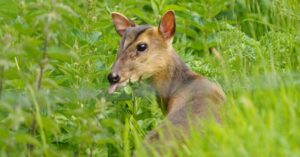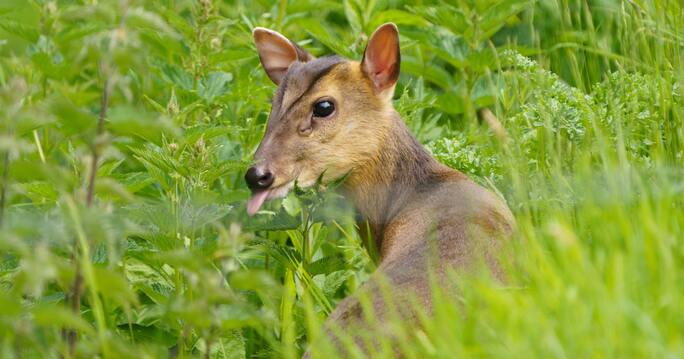In answer to a client wanting to know if the shrubs eaten by muntjac deer
In answer to a client wanting to know if the shrubs eaten by muntjac deer, on a development site, was due to these shrubs being too immature on planting. This was as suggested by a resident managing the resident’s Man-Co.
This is of course a case of a little knowledge is a dangerous thing. Perhaps not the most diplomatic response of course. The truth is that muntjac will eat almost anything. I have 3 in my grounds at home, and I fence them out. I once left the inner formal garden gate open and the pesky critters got in the main formal gardens (which I lovingly restored and extended – #busman’s holiday)! and they ate everything they normally would eat and quickly, namely roses, fruit trees, most flowers in the garden and everything except lavender and rosemary and Peony. They are not supposed to touch Rhododendron or yew – and, by and large, they left these, excepting a little nibble of the former every spring of the young leaves, to test the lie of the land I suppose – and they didn’t taste good – so thereafter they left them – eventually. However, they did continue to munch through ivy – which you’d think would be left alone being mildly poisonous .
Skimmia, the shrub faring worst on the development in question, will readily be eaten by muntjac – whatever age of the shrub. Of course the shrubs specified were mature – at 3L container size, and whilst nurseries are prone to fobbing off landscapers and their clients by selling off recently potted-on P9 stock – in a 3 Litre pot of soil, – (when they are supposed to leave these for 2-3 growing seasons to grow into their new pots), I have no evidence of course that that happened on this site, but whatever the facts – it would not make a difference to what the muntjac will eat. Best to plant several of the ‘curry plant’ or lavender around them, but it is no guarantee to avoid the pesky furry friends that are so abundant these days and have (of course) no predators, save the motor car.
The only real protection is a 1m+ fence, railing or mesh: They can jump to 1.2m but they rarely bother in reality. May be not the right aesthetic for the site or situation, and the little beasties do have long tongues, so expect a 100mm grazing line inside the fence.
Needless to say, I rounded up the pesky critters in my garden and shooed them out of the gate. They grace my front lawn only now, but have nibbled the geraniums to the ground, and have even nibbled the poisonous snow-drops. They normally don’t like the hot mustard tasting Honesty (a garden biennial), but in my garden they like it and the mature plants and seedings are eaten to stalks. They are I am afraid a rule to themselves, and make up the rule book as to what they will eat and tolerate, despite our best theories on their dos and don’ts.
It is an increasing problem on sites where houses front open countryside. For the open spaces, we generally only use robust native stock, for biodiversity reasons, and they do nibble that, but it grows faster in summer than they can nibble. For plots, you need the neat and maintenance limits of non-native evergreens, and it is not always appropriate or sunny enough a location for lavender and rosemary (both short-lived and sun loving shrubs), and off the record – there is always the consideration of enjoying a nice venison steak – after someone has shot it, (although I would be lynched for suggesting it). They are very tasty, and they are not native – hence being out of control. They have become the Japanese Knotweed of the animal world, like mink in rivers. Out of control and damaging to native ecosystems – but very cute and furry.
A long ramble – for which I apologise, but in summary there is no quick fix.
James
James Blake Associates
www.jba-landmarc.com
James Blake Associates
www.jba-landmarc.com





